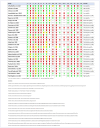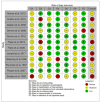Direct Composite Restorations on Permanent Teeth in the Anterior and Posterior Region - An Evidence-Based Clinical Practice Guideline - Part 1: Indications for Composite Restorations
- PMID: 39286910
- PMCID: PMC11748041
- DOI: 10.3290/j.jad.b5748881
Direct Composite Restorations on Permanent Teeth in the Anterior and Posterior Region - An Evidence-Based Clinical Practice Guideline - Part 1: Indications for Composite Restorations
Abstract
Purpose: This German S3 clinical practice guideline offers evidence-based recommendations for the use of composite materials in direct restorations of permanent teeth. Outcomes considered were the survival rates and restoration quality and process quality of the manufacturing process. Part 1 of this two-part presentation deals with the indication classes.
Materials and methods: A systematic literature search was conducted by two methodologists using MEDLINE and the Cochrane Library via the OVID platform, including studies up to December 2021. Six PICO questions were developed to guide the search. Recommendations were formulated by a panel of dental professionals from 20 national societies and organizations based on the collected evidence.
Results: Composite materials are a viable option for the direct restoration of cavity Classes I-V and may also be used for restorations with cusp replacement, and tooth shape corrections. In the posterior region, direct composite restorations should be preferred over indirect composite inlays. For Class V restorations, composite materials can be used if adequate contamination control and adhesive technique are ensured.
Conclusion: The guideline is the first to provide comprehensive evidence on the use of direct composite materials. However, further long-term clinical studies with comparators such as (modified) glass-ionomer cements are necessary. Regular updates will detail the future scope and limitations of direct composite restorations.
Keywords: adhesive restorations; composite resin; composite restorations; evidence-based medicine.
Figures




References
-
- Afrashtehfar KI, Emami E, Ahmadi M, Eilayyan O, Abi-Nader S, Tamimi F. Failure rate of single-unit restorations on posterior vital teeth: A systematic review. J Prosthet Dent. 2017;117:345–353. e348. - PubMed
-
- Al-Khayatt AS, Ray-Chaudhuri A, Poyser NJ, Briggs PF, Porter RW, Kelleher MG, et al. Direct composite restorations for the worn mandibular anterior dentition: a 7-year follow-up of a prospective randomised controlled split-mouth clinical trial. J Oral Rehabil. 2013;40:389–401. - PubMed
-
- Alonso V, Caserio M. A clinical study of direct composite full-coverage crowns: long-term results. Oper Dent. 2012;37:432–441. - PubMed
References Appendix 1
-
- Ajlouni R, Ajlouni K, Abu-Hanna A. Maximizing the esthetics of anterior teeth by conservative restorative dentistry: resin-based composite veneers. Texas Dent J. 2006;123:956–961. - PubMed
-
- Al-Khayatt AS, Ray-Chaudhuri A, Poyser NJ, Briggs PF, Porter RW, Kelleher MG, et al. Direct composite restorations for the worn mandibular anterior dentition: a 7-year follow-up of a prospective randomised controlled split-mouth clinical trial. J Oral Rehabil. 2013;40:389–401. - PubMed
-
- Baillod R, Krejci I, Lutz F. “Adhesive anterior tooth restorations” with the use of dentin bonding with and without a cavity liner. Schweizer Monatsschrift fur Zahnmedizin. 1994;104:290–296. - PubMed
-
- Balevi B. Caries risk and number of restored surfaces have impact on the survival of posterior composite restorations. Evid Based Dent. 2014;15:118–119. - PubMed
Publication types
MeSH terms
Substances
LinkOut - more resources
Full Text Sources

